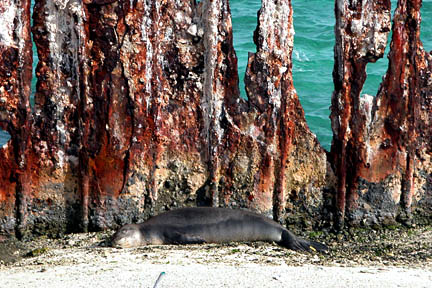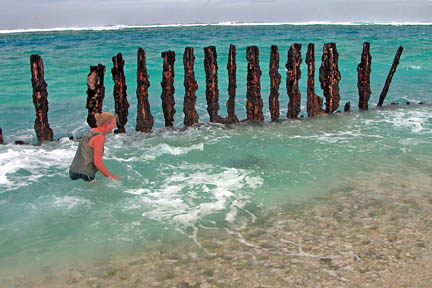
This monk seal pup accidentally swam inside one of Tern Island's worn-away seawalls and got stuck there. Biologists with the U.S. Fish and Wildlife Service placed the small seal on a stretcher, carried it to a nearby beach and released it. Without such human assistance, the endangered seal might have died.
Caretakers work to
keep Tern afloatPart 3 of 4
"There's a weaner caught inside the north sea wall," a U.S. Fish and Wildlife volunteer reports upon returning from the daily "entrapment walk" on Tern Island.
A weaner is a current year's monk seal pup whose mother has weaned it and left. As with all endangered animals, these Hawaiian monk seal offspring are precious commodities, central to the species' survival.
U.S. Fish and Wildlife manager Chris Eggleston sighs. "Let's wait awhile and see if it gets out on its own."
It does not, meaning he and another biologist must pick up the little seal in a stretcher net and take it to the beach.
The biologists save this seal with relative ease because it is small enough to carry. Adults, however, which weigh up to 600 pounds and fight ferociously when trapped, have to be herded out. If this fails, the seal might die inside the rusty sea wall that holds the island together.
That's because the sea wall is full of holes. This old metal breakwater is letting animals in, and the island, including junk left over from former military days, out. In short, Tern Island is falling apart.
No one is surprised that this man-made, 61-year-old island on a naturally eroding atoll is deteriorating. But it does frustrate U.S. Fish and Wildlife Service managers who inherited the island after it had already sprung a leak, and are now expected to keep it afloat.
Green sea turtles often get washed inside Tern Island's crumbling breakwater.
Tern Island, in the French Frigate Shoals Atoll about 550 miles northwest of Honolulu, is the main biological field station of the Hawaiian Islands National Wildlife Refuge. Tern, and the atoll's other tiny islands, are the last breeding grounds for most of Hawaii's threatened green sea turtles and endangered monk seals.
Besides these animals, hundreds of thousands of Hawaii's seabirds, all protected by federal and state laws, nest there.
French Frigate Shoals is like an isolated, open-air zoo. The door, however, is open only to native animals and their caretakers.
This off-limits policy is one of several dilemmas facing Fish and Wildlife Service managers who depend on tax dollars to keep the place running. It's hard to get people to care about something they aren't allowed to see.
"When Midway was open to the public, people could visit there, see the wildlife and get an idea of what we're doing here," said Alex Wegmann, a Fish and Wildlife Service biologist who worked on Tern Island.
Midway Atoll's visitor program, however, has temporarily ended due in part to the high cost of operating in a remote environment with aging facilities.
But Tern Island has bigger problems than finding parts for old machines. The island is held together on three sides (the fourth is a beach) by steel bulkheads that are rusting through, pulling away and falling off. Besides this being a hazard to the animals, which routinely get trapped between the land and the metal, the island's coral base is gradually washing away though the holes.
FWS volunteer biologist Christy Hand spotted this trapped turtle during a morning patrol of the island.
No one is giving up on the island, but if managers did decide to let the ocean reclaim it, the expense of clearing it off and leaving it clean would be enormous. Besides several large buildings, the U.S. Coast Guard left behind a pile of junk called Bulky Dump, which among other things contains discarded transformers. These have leached toxic PCBs into the surrounding soil.
Fixing the breakwater and removing the dump and its contaminants is cheaper than leaving, but that doesn't mean it's inexpensive. Repairs involve building sloping rock supports in some areas and installing concrete-capped metal sheet-piles in others. These are costly undertakings, and it's hard to get money for a wildlife protection project that few people know about.
In 2000 and 2001, however, Congress approved more than $10.3 million to shore up Tern's edges. Combined with funds of its own earmarked for the project, the Fish and Wildlife Service had a total of $11.8 million to invest in Tern Island repairs. This is about half the cost estimated by the Army Corps of Engineers, the agency managing the project for Fish and Wildlife Service, and will fix only about half the island.
Managers have chosen to go ahead anyway, installing the less expensive rock walls first. The idea is to protect as much of the island and its wildlife as possible with the available funds while applying for more to complete it.
In 2001, workers began the work of clearing part of the island of animals to create a staging area for the sea wall builders. This is no small task on an island shore to shore with nesting seabirds, breeding monk seals and egg-laying turtles. In November of that year, the best time for the least disturbance of wildlife, two newly hired biologists laid black fabric over the ground on the west end of the island to gently persuade ground-nesting birds to relocate.
After wading in and catching it, she carried it ashore. Workers there measured and tagged the young turtle, then released it safely outside the sea wall.
Before work could begin, though, a major hurdle had to be crossed: The Coast Guard had to clean up its mess. At Bulky Dump, large pieces of rusting metal, broken glass, tangled wire and more spill from the island into the ocean. Besides being dangerous to both humans and wildlife, the soil in that area contains PCBs.
Cost estimates for this cleanup were in the range of $2.5 million. But the Coast Guard did not provide funding, and work on the sea wall project ground to a halt.
While waiting for the Coast Guard to remove its wastes, Fish and Wildlife Service managers began working on the old Coast Guard barracks, home to Tern's biologists. If the facility could accommodate the 14 to 20 sea wall builders who will have to live and work on the island for several months, as well as the 10 or so biologists who routinely live there, contractors wouldn't need to ship, and charge for, temporary housing trailers.
The Coast Guard still has not agreed to pay for the removal of Bulky Dump, but the project continues. Plans are to leave the dump alone and install rock revetments on both sides of it. While workers build these breakwaters around half the island, managers will continue to ask the Coast Guard to help remove their trash and will also look for funding to finish the island's other half with metal sheet-piles and additional rocks.
Construction began in March, but the Tern Island ship could still sink. Unless the cash-strapped Fish and Wildlife Service gets enough money to plug all the holes, this field station will fade away and take its breeding grounds with it.
In the meantime, biologists stand by, watching the metal sea walls disappear a chunk at a time, and trekking the island daily to rescue animals caught inside.
— ADVERTISEMENTS —
— ADVERTISEMENTS —





